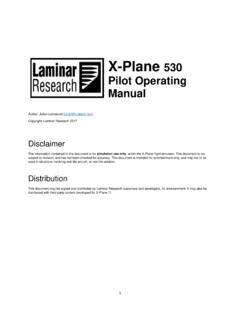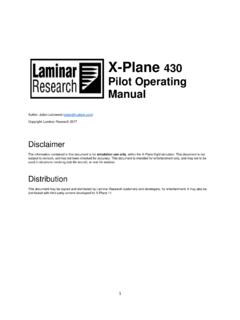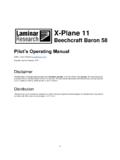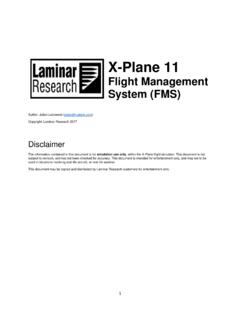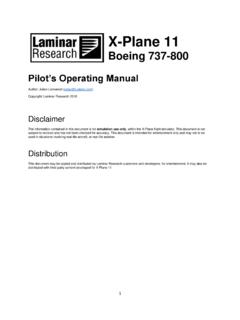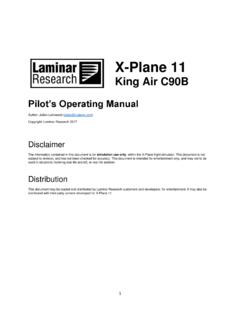Transcription of X-Plane 11
1 1 X-Plane 11 King Air C90B Pilot s operating Manual Author: Julian Lockwood Copyright: Laminar Research 2017 Disclaimer The information contained in this document is for simulation use only, within the X-Plane flight simulator. This document is not subject to revision, and has not been checked for accuracy. This document is intended for entertainment only, and may not to be used in situations involving real-life aircraft, or real-life aviation. Distribution This document may be copied and distributed by Laminar Research customers and developers, for entertainment.
2 It may also be distributed with third-party content developed for X-Plane 11. 2 Contents Background: The King Air Model 90 Series .. 4 C90 Specifications .. 4 The X-Plane King Air C90B .. 5 Views and Controls .. 6 Creating Quick Look views .. 7 operating the controls .. 10 Assigning peripheral devices .. 12 A Tour of the Cockpit .. 14 Fuel Management Panel .. 14 Pilot s Primary Instruments .. 16 Engine Instrumentation .. 19 Avionics Panel .. 21 Main switch panel and Landing Gear .. 24 Throttle Quadrant and Center Console .. 28 Copilot s Primary Instruments .. 31 Overhead Panel.
3 34 Overhead Rotary Controls .. 35 Annunciator Panel .. 36 EFIS Control Panel and Autopilot 41 EFIS Control Panel .. 41 Autopilot Operation .. 43 Flight Planning .. 47 Fuel Calculation .. 48 Taxi Fuel .. 48 Trip Fuel .. 48 Contingency Fuel .. 49 Alternate Destination Fuel .. 49 Final Reserve Fuel .. 49 Additional Fuel .. 49 Discretionary Fuel .. 49 Final Calculated Fuel Load .. 49 Weight & 50 3 Check Lists .. 55 Operational Speeds .. 63 4 Background: The King Air Model 90 Series Photo Credit: Wikipedia The Beech Aircraft Corporation first conceived of the King Air Model 90 series in 1961.
4 At that time, the aircraft was designated the Beechcraft Model 120, and was derived from the company s successful Queen Air series (a twin engine piston powered light aircraft produced from 1960 to 1978). The new King Air was to be a civil utility aircraft , with military variants also to be adopted by the US Army, the US Navy, and other defense forces around the world. Although based on the Queen Air, the new King Air featured the introduction of Turbo Prop power, utilizing two Pratt & Whitney PT6A engines. The PT6 is one of the most popular Turbo Prop engines in history, known for extreme reliability that allows for a mean time between overhaul (MTBO) of up to 9,000 hours.
5 The original PT6A s developed between 580 and 920 shaft horsepower, although later variants have considerably exceeded this. Test flights began in May of 1963, and Beechcraft started taking orders the following month, with the first production aircraft delivered on October 8th 1964. The model C90 was introduced in 1971, with an increased wingspan, upgraded PT6A-20A engines, and a maximum take-off weight of 9,650 lb. (4,378 kg). A further derivative of the C90, designated C90B came in 1992, with airframe improvements, four-bladed propellers, and propeller synchrophasing (to reduce cabin noise).
6 The C90B featured Pratt & Whitney PT6A-21 engines. To date, over 3,100 King Air aircraft (various variants) have sold. The aircraft remains in production. C90 Specifications Engine: Model ---------------------------------------- - 2 x Pratt & Whitney PT6A-21 Power ---------------------------------------- - 550-shaft horsepower per engine Propeller ---------------------------------------- - Constant Speed Fuel: Capacity ---------------------------------------- - 384 Gallons / 2,573 Lbs. Recommended fuel ---------------------------------------- - JP-4; JP-5; Jet A; Jet A-1; Jet B Fuel Burn (average) ---------------------------------------- - 280 Kg.
7 Per hour / 617 Lb. per hour Weights and Capacities: Max. Takeoff Weight ---------------------------------------- - 9,650 Lb. / 4,377 Kg. Max. Landing Weight ---------------------------------------- - 9,168 Lb. / 4,159 Kg. Standard Empty Weight ---------------------------------------- - 5,765 Lb. / 2,615 Kg. Max. Useful Load ---------------------------------------- - 3,885 Lb. / 1,762 Kg. Baggage Capacity ---------------------------------------- - 350 Lb. / 159 Kg. Performance: Max. operating Speed ---------------------------------------- - 208 Knots Stall Speed (Clean) ---------------------------------------- - 89 Knots Stall Speed (Landing Configuration) ---------------------------------------- - 76 Knots Best Climb Rate ---------------------------------------- - 1,955 Feet Per Minute @ 9,650 Lb.
8 Wing Loading ---------------------------------------- - Lb. / Sq. Ft. Power Loading ---------------------------------------- - Lb. / Hp. Service Ceiling ---------------------------------------- - 28,100 Ft. @ 9,650 Lb. 5 The X-Plane King Air C90B Unlike other flight simulators, X-Plane employs a technique called blade element theory. This technique uses the actual shape of the aircraft (as modeled in the simulator), and breaks down the forces on each part separately. The force of the air acting on each component of the model is individually calculated, and combined, to produce extremely realistic flight.
9 When you fly an airplane in X-Plane , there are no artificial rules in place to govern how the aircraft behaves. Your control inputs move the control surfaces of the aircraft, and these interact with the flow of air around it. As such, you may consider that you are really flying the aircraft. Because of this technique, an aircraft must be modeled with great accuracy in X-Plane , in order that is behave like its real-life counterpart. This means the fuselage, wings and tail surfaces must be the right size and shape, the center of lift and center of gravity must be in the right places, and the engine(s) must develop the right amount of power.
10 In fact, there are a great many properties that must be modeled correctly to achieve a high-fidelity flight model. The Beechcraft King Air C90B in X-Plane has been modeled by our design team with a degree of accuracy that ensures its flight characteristics are very like those of the real aircraft. However, despite this, some differences will be apparent, because even the smallest factor plays into the ultimate behavior of the aircraft, both in real life, and in X-Plane . The systems modeling of this aircraft involves some compromise too, because of the high degree of complexity present in the real aircraft.
